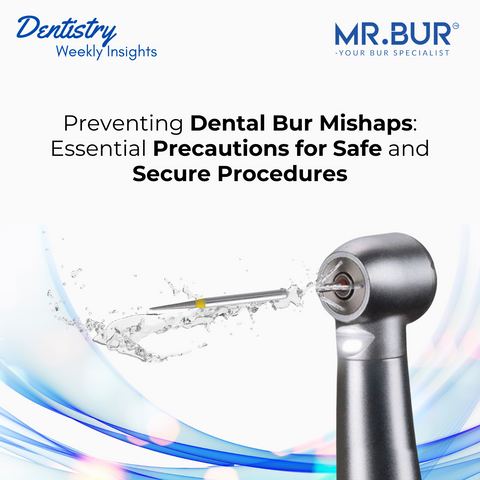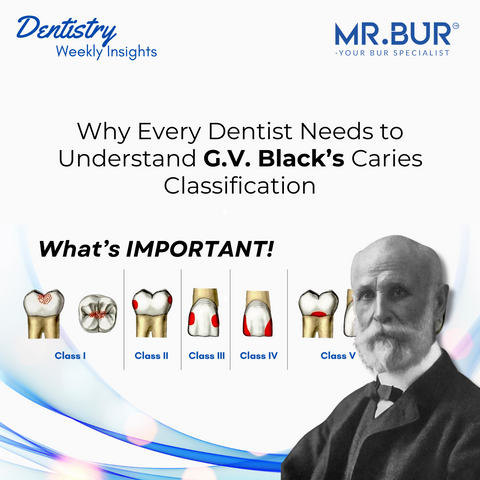Tooth preparation is a fundamental aspect of restorative and cosmetic dentistry. Mastering various preparation techniques is essential for delivering high-quality dental care. This guide provides detailed insights into the main categories of tooth preparation: Crown, Veneer, Inlay and Onlay, Cavity, Orthodontic, and Gingival Preparation. Whether you're a seasoned practitioner or a dental student, this comprehensive overview aims to enhance your practice and patient outcomes. The use of dental burs, essential tools in tooth preparation, will be highlighted in each technique.
Crown Preparation
Indications of use
Crown preparation involves several critical steps to ensure the crown fits well and functions effectively.
The key steps include:
- Initial Assessment: Evaluate the tooth’s condition and take X-rays to assess root and bone health.
- Anesthesia: Administer local anesthesia to ensure patient comfort.
- Tooth Reduction: Use a high-speed handpiece with diamond burs to reduce the tooth's size to accommodate the crown, ensuring adequate space for the crown material. Chamfer and shoulder margin tapered burs are commonly used.
- Tapered Round End Diamond Bur FG : Ideal for creating a chamfer margin.
- Tapered Flat End Diamond Bur FG : Suitable for shoulder preparations.
- Margin Creation: Create a margin that’s smooth and well-defined to ensure a perfect crown fit. Fine-grit diamond burs are ideal for this step.
- Impressions: Take accurate impressions of the prepared tooth for precise crown fabrication.
- Temporary Crown: Place a temporary crown to protect the prepared tooth while the permanent crown is being made.
- Cement he final crown: Ensure the crown fits accurately and securely, using resin bonded cement appropriate for the material of the crown.
- Polish the crown surface: Use composite polishers to gently polish the external surface of the crown to high shine based on customer preferences.
Each step requires precision and attention to detail. For instance, during tooth reduction, ensuring the appropriate amount of enamel and dentin is removed can be challenging. Inadequate reduction led to a poorly fitting crown and patient discomfort. This experience underscored the importance of meticulous preparation. Therefore, pick the use of bur wisely is one major part.
Common Mistakes to Avoid
Avoiding common mistakes can significantly improve crown preparation outcomes. Some frequent errors include:
- Over-Reduction or Under-Reduction: This can compromise the tooth’s structural integrity or result in an ill-fitting crown.
- Improper Margin Design: A poorly defined margin can cause crown dislodgment or gaps.
- Inadequate Retention: Ensure sufficient tooth structure remains for crown retention.
Veneer Preparation
Indications of use
- Evaluation: Assess the patient's dental health and discuss their aesthetic goals.
- Preparation: Use a depth marker diamond bur with a tapered bur to remove a thin layer of enamel.
- Depth Marker Diamond Bur FG : Ideal for
- 0.3mm Depth Marking
- 0.4mm Depth Marking
- 0.5mm Depth Marking
- Tapered Diamond Bur FG : Ideal for removing enamel surface
- Impression: Take an accurate impression of the prepared teeth.
- Temporary Veneers: Place temporary veneers if needed.
- Bonding: Bond the final veneers using a strong adhesive, ensuring proper fit and alignment.
- Polish: Use gentle pressure and smooth, controlled motions to polish the entire surface of the veneer.
Pain Management
Effective pain management strategies, including local anesthesia and dental bur choices, can enhance patient comfort during veneer preparation.
Inlay and Onlay Preparation
Indications for Use
Inlays and onlays are ideal for restoring moderately decayed or damaged teeth, offering a conservative alternative to crowns.
- Decay Removal: Use a round carbide bur to remove decayed tissue and shape the cavity.
- Carbide Round Bur (330): Efficient for initial decay removal.
- Cavity Preparation: Employ a tapered diamond bur to refine the cavity shape, ensuring smooth margins.
- Tapered Diamond Bur: Suitable for refining cavity walls and margins.
- Impression: Take an accurate impression of the prepared cavity.
- Temporary Restoration: Place a temporary restoration if needed.
- Final Placement: Bond the inlay or onlay, ensuring a snug fit and proper occlusion.
Cavity Preparation
Indication of uses
- Diagnosis: Use diagnostic tools, including radiographs, to identify carious lesions.
- Anesthesia: Administer local anesthesia to ensure patient comfort.
- Decay Removal: Use a round bur to carefully remove decayed tissue.
- Round Bur : Commonly used for decay removal.
- Cavity Shaping: Employ a high-speed handpiece with a tapered diamond bur to shape the cavity, ensuring smooth margins and proper retention.
- Tapered Diamond Bur: Suitable for shaping cavity walls.
- Restoration Placement: Place the appropriate restorative material, ensuring a snug fit and proper occlusion.
Minimally Invasive Methods
Minimally invasive cavity preparation techniques, such as air abrasion, laser dentistry and precise dental bur, preserve more natural tooth structure and reduce patient discomfort.
Orthodontic Preparation
Indication of uses
- Initial Assessment: Evaluate the patient's orthodontic needs using X-rays and impressions.
- Tooth Preparation: In some cases, tooth reduction or recontouring may be necessary, using diamond burs to create space for brackets or aligners.
- Interproximal Reduction Bur (Anterior) : Used for slenderizing anterior teeth to create a 0.3 - 0.5mmspace.
- Interproximal Reduction Bur (Posterior) : Used for slenderizing posterior teeth to create a 0.45 - 0.5mm space.
- Bracket Placement: Bond brackets to the teeth, ensuring proper alignment.
- Insert archwire: Thread an initial archwire through the brackets or attachments.
- Make necessary adjustments: Ensure all brackets, attachments, and wires are properly positioned and functioning.

Working with experts over 50 years of experience in the dental bur industry, MR.BUR US is dedicated to provide the highest quality dental burs on the market.
Diamond Burs, Carbide Burs, Surgical & Lab Use Burs, Endodontic burs, IPR Kit, Crown Cutting Kit, Gingivectomy Kit, Root Planning Kit, Composite Polishers, High Speed Burs, Low Speed Burs
Subscribe our newsletter now!





